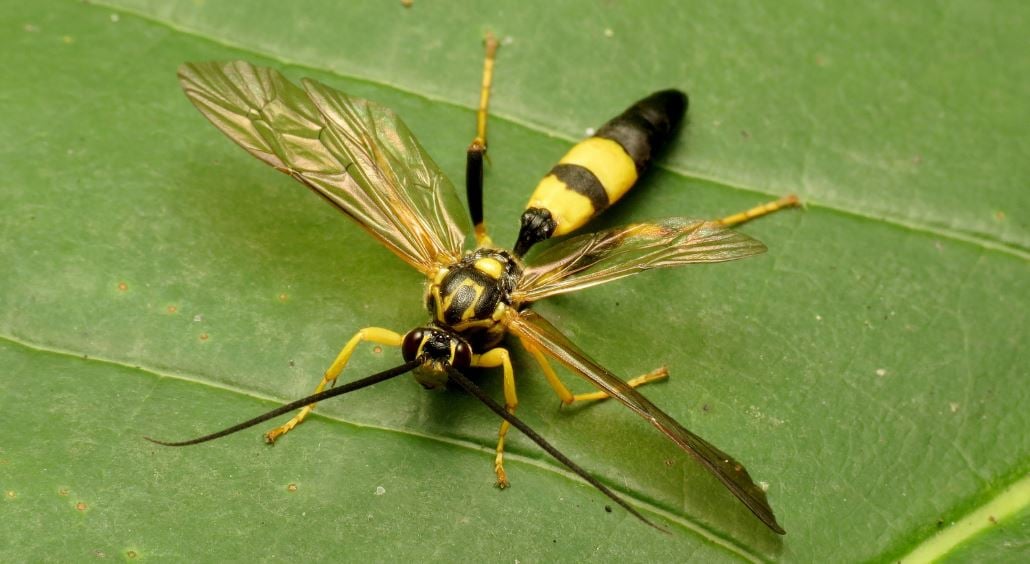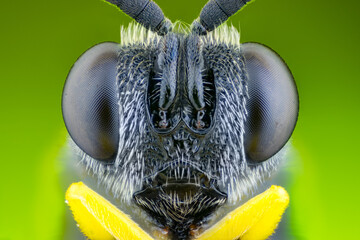jack
The Legendary Troll King
Parasitic wasps switch off the immune systems of fruit flies by draining calcium from the flies' blood cells, a finding that offers new insight into how pathogens break through a host's defenses.
"We believe that we have discovered an important component of cellular immunity, one that parasites have learned to take advantage of," says Emory University biologist Todd Schlenke, whose lab led the research.
The Proceedings of the National Academy of Sciences (PNAS) published the results, showing how a wasp version of a conserved protein called SERCA, which normally functions to pump calcium from the cell cytoplasm to the endoplasmic reticulum, can block a host's cellular immune response.
"Before our study, there were hints that calcium signaling was important for blood cell activation following infection, but the fact that a parasite actively suppresses this signaling shows how important it is, Schlenke says. He adds that the insects can serve as a model for more complex human immune systems.
"It's incredible the way the wasps use a protein in their venom to control the flies at a molecular level," says Nathan Mortimer, a post-doctoral fellow in the Schlenke lab who conducted the experiments. "Instead of killing the fly immune cells, the wasps actually take over blood-cell signaling, manipulating the host's behavior from the bottom up."
The research team also included Emory biologist Balint Kacsoh; Jeremy Goecks and James Taylor, from Emory's departments of biology and mathematics and computer science; and James Mobley and Gregory Bowersock of the University of Alabama, Birmingham.
Fruit flies and the tiny wasps that parasitize them have co-evolved complex strategies of attack and defense. The wasps inject their eggs into the body cavities of fruit fly larvae, along with venom that aims to suppress the flies' cellular immunity. If the flies fail to kill the wasp egg, a wasp larva hatches inside the fruit fly larva and begins to eat its host from the inside out.
"The wasp larvae have these sharp appendages, like the fingers of Edward Scissorhands, that they use to stick into the fly tissue and start eating," Mortimer says. "It's a brutal process."
In previous research, the Schlenke lab has shown how fruit flies sometimes use alcohol in rotting fruit as a drug to kill the wasps.
In the current study, the researchers focused on the molecular attack strategies of the wasps. After sequencing the transcriptome of the newly described wasp species Ganaspis sp.1, they took a proteomic approach to identify peptide sequences out of the wasp's venom gland, which they could then link back to full-length transcript sequences.
"We found that the venom of Ganaspis sp.1 is a toxic cocktail of 170 different proteins," Schlenke says, "but the most prominent component was the SERCA calcium pump protein. That really surprised us."
Calcium pumps are found in the membranes of every living cell of every animal, and are needed to maintain ionic homeostasis and cellular stability. One type of pump moves calcium ions out of the endoplasmic reticulum and into the cytoplasm where they transmit signals that activate other proteins. The SERCA calcium pump operates in the opposite direction, sucking calcium ions out of the cytoplasm and back into storage.
"We wondered why the wasps would inject the flies with a protein that the flies already have, and that every cell needs to function," Schlenke says. "How could that be an infection strategy?"
The researchers knew of studies suggesting that a calcium burst in cytoplasm is associated with the activation of human blood cells. They wondered if something similar was happening with the flies.
Mortimer conducted experiments on a transgenic fly strain with cells that fluoresce in the presence of calcium. He found that the fly blood cells release a burst of calcium into their cytoplasm, and that this activates the blood cells to start homing in on the wasp eggs. Genetically increasing or decreasing blood-cell calcium levels makes the flies more or less resistant to the parasite infection.
"The wasp venom prevents this calcium burst, and it's like the fly blood cells don't realize they're supposed to be responding to infection," Mortimer says. "The venom essentially sucks the calcium out of the fly's blood cells."
The experiments showed that the wasp venom is specifically targeted to the fly blood cells, and has no effect on other cells.
An unresolved question is how a SERCA protein, which is hydrophobic and normally resides in an oily membrane, moves out of a wasp venom cell and makes its way into a fly blood cell.
"We have no idea how it works," Schlenke says, "but somehow this calcium pump moves through all these environments and finds its way into its target cells."
The researchers hypothesize that virus-like particles in the wasp's venom may be involved. "If they aren't really viruses, they seem to be some virus-like thing that the wasp has invented," Schlenke says. "It's pure speculation, but we think maybe the wasps use these particles as delivery vehicles for the calcium pumps."
Previous research has established that fruit fly immune signaling pathways have homologues in humans, making fruit flies a valuable model for learning about human immunity. That work led to the award of the 2011 Nobel Prize in physiology or medicine to Jules Hoffmann, a fruit fly immunologist.
Studying the wasp-fly battle for survival at the molecular level provides a powerful new tool for unlocking more secrets of immunity that could apply to human health, Mortimer says.
"I'm also interested in using the flies to understand more about the immune systems of mosquitos and other insect vectors of human disease," he says. "If we could somehow boost vector insect immunity, it could decrease transmission of human disease like malaria."
"We believe that we have discovered an important component of cellular immunity, one that parasites have learned to take advantage of," says Emory University biologist Todd Schlenke, whose lab led the research.
The Proceedings of the National Academy of Sciences (PNAS) published the results, showing how a wasp version of a conserved protein called SERCA, which normally functions to pump calcium from the cell cytoplasm to the endoplasmic reticulum, can block a host's cellular immune response.
"Before our study, there were hints that calcium signaling was important for blood cell activation following infection, but the fact that a parasite actively suppresses this signaling shows how important it is, Schlenke says. He adds that the insects can serve as a model for more complex human immune systems.
"It's incredible the way the wasps use a protein in their venom to control the flies at a molecular level," says Nathan Mortimer, a post-doctoral fellow in the Schlenke lab who conducted the experiments. "Instead of killing the fly immune cells, the wasps actually take over blood-cell signaling, manipulating the host's behavior from the bottom up."
The research team also included Emory biologist Balint Kacsoh; Jeremy Goecks and James Taylor, from Emory's departments of biology and mathematics and computer science; and James Mobley and Gregory Bowersock of the University of Alabama, Birmingham.
Fruit flies and the tiny wasps that parasitize them have co-evolved complex strategies of attack and defense. The wasps inject their eggs into the body cavities of fruit fly larvae, along with venom that aims to suppress the flies' cellular immunity. If the flies fail to kill the wasp egg, a wasp larva hatches inside the fruit fly larva and begins to eat its host from the inside out.
"The wasp larvae have these sharp appendages, like the fingers of Edward Scissorhands, that they use to stick into the fly tissue and start eating," Mortimer says. "It's a brutal process."
In previous research, the Schlenke lab has shown how fruit flies sometimes use alcohol in rotting fruit as a drug to kill the wasps.
In the current study, the researchers focused on the molecular attack strategies of the wasps. After sequencing the transcriptome of the newly described wasp species Ganaspis sp.1, they took a proteomic approach to identify peptide sequences out of the wasp's venom gland, which they could then link back to full-length transcript sequences.
"We found that the venom of Ganaspis sp.1 is a toxic cocktail of 170 different proteins," Schlenke says, "but the most prominent component was the SERCA calcium pump protein. That really surprised us."
Calcium pumps are found in the membranes of every living cell of every animal, and are needed to maintain ionic homeostasis and cellular stability. One type of pump moves calcium ions out of the endoplasmic reticulum and into the cytoplasm where they transmit signals that activate other proteins. The SERCA calcium pump operates in the opposite direction, sucking calcium ions out of the cytoplasm and back into storage.
"We wondered why the wasps would inject the flies with a protein that the flies already have, and that every cell needs to function," Schlenke says. "How could that be an infection strategy?"
The researchers knew of studies suggesting that a calcium burst in cytoplasm is associated with the activation of human blood cells. They wondered if something similar was happening with the flies.
Mortimer conducted experiments on a transgenic fly strain with cells that fluoresce in the presence of calcium. He found that the fly blood cells release a burst of calcium into their cytoplasm, and that this activates the blood cells to start homing in on the wasp eggs. Genetically increasing or decreasing blood-cell calcium levels makes the flies more or less resistant to the parasite infection.
"The wasp venom prevents this calcium burst, and it's like the fly blood cells don't realize they're supposed to be responding to infection," Mortimer says. "The venom essentially sucks the calcium out of the fly's blood cells."
The experiments showed that the wasp venom is specifically targeted to the fly blood cells, and has no effect on other cells.
An unresolved question is how a SERCA protein, which is hydrophobic and normally resides in an oily membrane, moves out of a wasp venom cell and makes its way into a fly blood cell.
"We have no idea how it works," Schlenke says, "but somehow this calcium pump moves through all these environments and finds its way into its target cells."
The researchers hypothesize that virus-like particles in the wasp's venom may be involved. "If they aren't really viruses, they seem to be some virus-like thing that the wasp has invented," Schlenke says. "It's pure speculation, but we think maybe the wasps use these particles as delivery vehicles for the calcium pumps."
Previous research has established that fruit fly immune signaling pathways have homologues in humans, making fruit flies a valuable model for learning about human immunity. That work led to the award of the 2011 Nobel Prize in physiology or medicine to Jules Hoffmann, a fruit fly immunologist.
Studying the wasp-fly battle for survival at the molecular level provides a powerful new tool for unlocking more secrets of immunity that could apply to human health, Mortimer says.
"I'm also interested in using the flies to understand more about the immune systems of mosquitos and other insect vectors of human disease," he says. "If we could somehow boost vector insect immunity, it could decrease transmission of human disease like malaria."



